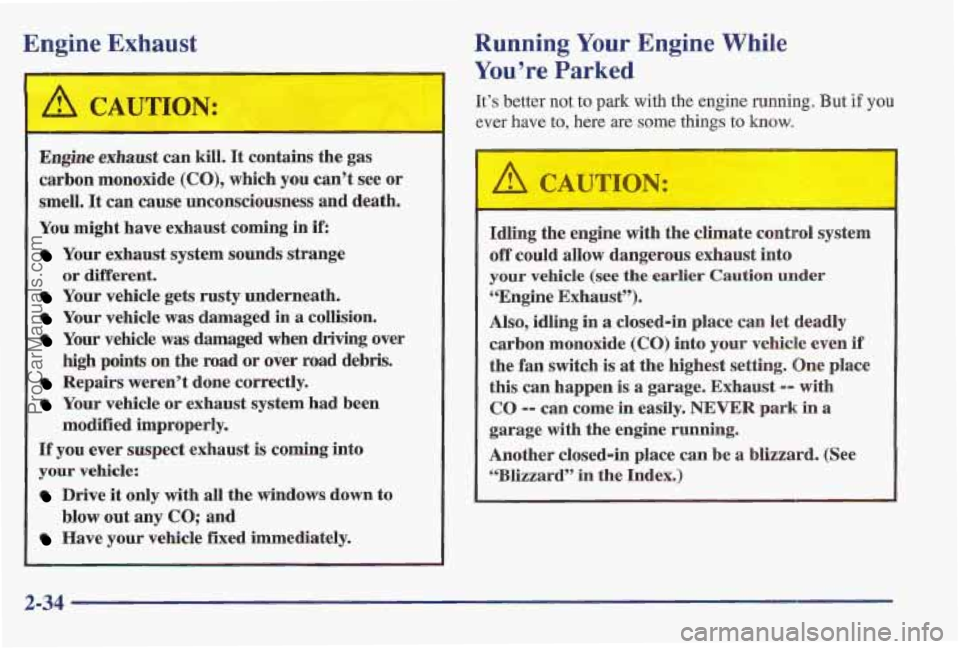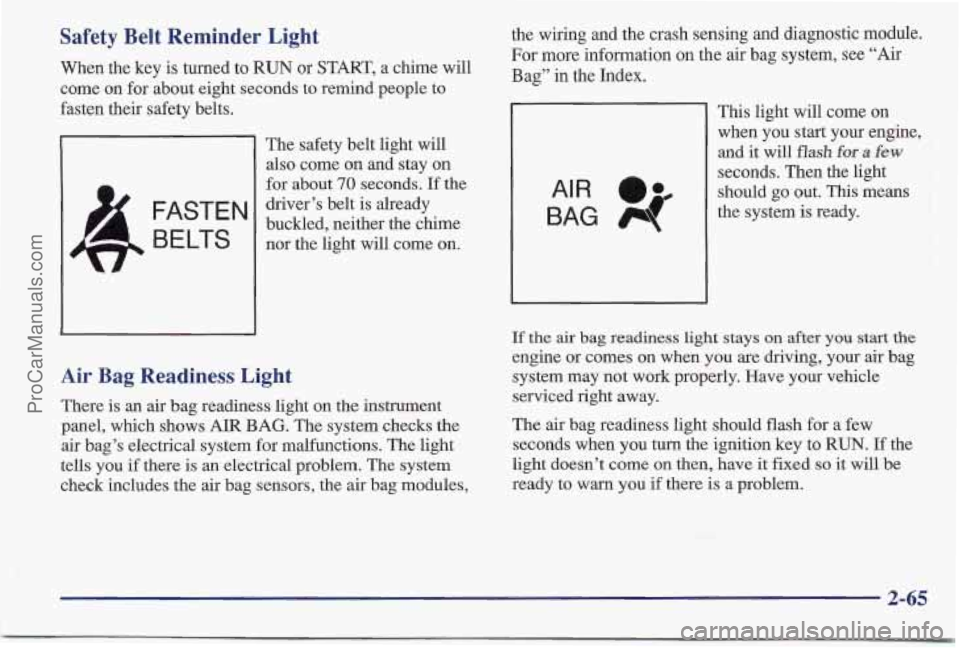Page 83 of 405
Shifting Into PARK (P)
I-
It can be dangerous to get out of your vehicle if
the shift lever is not fully in PARK (P) with the
parking brake firmly set. Your vehicle can roll.
If you have left the engine running, the vehicle
can move suddenly. You
or others could be
injured.
To be sure your vehicle won’t move, even
when you’re
on fairly level ground, use the steps
that follow.
If you’re pulling a trailer, see
“Tomwing
a Trailer” in the Index.
Steering Column Shift Lever
1. Hold the brake pedal down with your right foot and
set the parking brake.
2. Move the shift lever into PARK (P) like this:
Pull the lever toward you.
2-30
ProCarManuals.com
Page 85 of 405

Leaving Your Vehicle With the
Engine Running
It can be ldangerous to leave your vehicle with
the engine running. Your vehicle could
move
sudldenly if the shift lever is not fully in PARK (P)
with the parking brake firmly set, And, if you
leave the vehicle with the engine running, it ,could
overheat and even catch
fire. You or others could
be injured. Don’t leave your vehicle with the
engine running unless you have
to.
If you have to leave your vehicle with the engine
running, be
sure your vehicle is in PARK (P) and your
parking brake is firmly set before you leave it. After
you’ve
moved the shift lever into the PARK (I?)
position, hold the regular brake pedal down. Them, see if
you can move the shift lever away from PARK (P)
without first pulling it toward you (or, if you have the
console shift lever, without fist pushing the button).
If
you can, it means that the shift lever wasn’t fully locked
into PARK (P).
Torque Lock
If you are parking on a hill and you don’t shift your
transaxle into PARK (P) properly, the weight of the
vehicle
may put too much force on the parking pawl in
the transaxle. You may find it difficult to pull the shift
lever out of
PARK (P). This is called “torque lock.” To
prevent torque lock, set the parking brake and then shift
into
PARK (P) properly before you leave the driver’s
seat.
To find out how, se’e “Shifting Into PARK (P)” in
the Index.
When you
are ready to drive, move the shift lever out of
PARK (P) before you release the parking brake.
If torque lock does occur, you may need to have another
vehicle
push yours a little uphill to take some of the
pressure from the paking pawl in the transaxle, so you
can pull the shift lever out of PARK
(P).
ProCarManuals.com
Page 87 of 405

Engine Exhaust
-
I A CAUTION:
- - -
Engine exhaust can kill. It contains the gas
carbon monoxide
(CO), which you can’t see or
smell.
It can cause unco~~sciousness and death.
You might h’ave exhaust coming in if:
Your exhaust system sounds strange
Your vehicle gets rusty underneath.
Your vehicle was damaged in a collision.
Your vehicle was damaged when driving over
high points on the road or over road debris.
Repairs weren’t done correctly.
Your vehicle or exhaust system had belen
If you ever suspect exhaust is coming into
your vehicle:
Drive it only with all the windows down to
Have your vehicle fixed immediately,
or dBerent.
modified improperly,
blow out any
CO; and
1
Running Your Engine While
You’re Parked
It’s better not to park with the engine running. But if you
ever have to, here are some things to know.
1 A CAUTION: -
Idling the engine with the clirn 3 control system
off could allow dangerous exhaust into
your vehicle (see the earlier Caution under
((Engine Exhaust’)).
Also, idling
in a closed-in place can let deadly
carbon monoxide
(CO) into your vehicle even if
the fan switch
is at the highest setting, One place
this can happen is a garage. Exhaust
-- with
CO
-- can come in easily. NEVER park in a
garage with the engine running.
Another closed-in place can
be a blizzard. (See
CLBlizzardS’ in the Index.)
2-34
ProCarManuals.com
Page 88 of 405
It can be dangerous to get out of your vehicle if
the shift lever is not fully in
PARK (P) with the
parking brake firmly set. Your vehicle can roll.
Don’t leave your vehicle when the engine is
running unless you have to. If you’ve left the
engine running, the vehicle can move suddenly.
You or others could be injured. To be sure your
vehicle won’t move, even when you’re on fairly
level ground, always set your parking brake and
1 move the shift lever to PARK (P).
Follow the proper steps to be sure your vehicle won’t
move. See “Shifting Into
PARK (P)” in the Index.
If you are parking on a hill and if you’re pulling a
trailer, also
see “Towing a Trailer” in the Index.
Windows
Power Windows
Switches on the driver’s door panel control each of the
windows when the ignition is on or when Retained
Accessory Power is active. In addition, each passenger
door has a control switch far its
own window.
2-35
ProCarManuals.com
Page 100 of 405

Theater Dimming
This feature allows for a three to five-second fade out
of the courtesy lamps instead
of immediate turn off.
Exit Lighting
With this feature, the interior lamps will come on for
25 seconds after you remove the key from the ignition.
This will give you time to find the door pull handle
or
lock switches as you exit the vehicle.
Illuminated Entry (Option) Front Reading Lamps
These lamps and
the
interior courtesy lamps
will come
on when you
open the doors.
When you press the unlock button on the optional
Remote Keyless Entry transmitter, the lamps inside your
TO turn on a reading lamp when the doors are closed,
vehicle will go
on. These lamps will go off after about press either switch. Press it again to turn the lamp off.
25 seconds, or when you start your engine. Pressing the
lock button on your Remote Keyless Entry transmitter
will turn the lights immediately off.
If a door is left ajar, your interior lamps will turn off
after
10 minutes to save your battery.
To avoid draining your vehicle’s battery, be sure to turn
off the reading lamps when leaving your vehicle.
2-47
ProCarManuals.com
Page 117 of 405

Tachometer
The tachometer shows your
engine speed in revolutions
per minute (rpm).
Do not
run your engine at speeds in
the red area.
Warning Lights, Gages and Indicators
This part describes the warning lights and gages that
may b’e on your vehicle.
The pictures will help you
locate them.
Warning lights and gages can signal that something
is
wrong before it becomes serious enough to cause an
expensive repair
or replacement. Paying attention to
your warning lights and gages could also save you or
others from injury.
Warning lights come on when there may be or is a
problem with one of your vehicle’s functions.
As you
will see in the details on the next few pages, some
warning lights
come on briefly when you start the
engine just to let you know they’re working.
If you are
familiar with this section, you should not be alarmed
when this happens.
Gages can indicate when there may be or
is a problem
with one
of your vehicle’s functions. Often gages and
warning lights work together to let you know when
there’s a problem with your vehicle.
When one of the warning lights comes on and stays on
when you are driving, or when one of the gages shows
there may be a problem, check the section that tells you
what to
do about it. Please follow this manual’s advice.
Waiting to do repairs can be costly
-- and even
dangerous.
So please get to know your warning lights
and gages. They’re a big help.
Your vehicle may also have a driver information system
that works
along with the warning lights and gages. See
“Driver Information Center” in the Index.
2-64
ProCarManuals.com
Page 118 of 405

Safety Belt Reminder Light
When the key is turned to RUN or START, a chime will
come on for about eight seconds to remind people to
fasten their safety belts.
The safety belt light will
also come on and stay on
for about
70 seconds. If the
driver’s belt is already
buckled, neither the chime
B E LTS nor the light will come on.
FASTEN
Air Bag Readiness Light
There is an air bag readiness light on the instrument
panel, which shows AIR
BAG. The system checks the
air bag’s electrical system for malfunctions. The light
tells you
if there is an electrical problem. The system
check includes the air bag sensors, the air bag modules, the
wiring and the crash sensing and diagnostic module.
For more information on the air bag system, see “Air
Bag” in the Index.
This light will come on when you start your engine,
and
it will flash for a few
seconds. Then the light
should go out. This means
the system
is ready.
If the air bag readiness light stays on after you start the
engine or comes on when you are driving, your air bag
system may not work properly. Have your vehicle
serviced right away.
The air bag readiness light should flash for a few
seconds when you turn the ignition key to RUN.
If the
light doesn’t
come on then, have it fixed so it will be
ready to warn you
if there is a problem.
2-65
ProCarManuals.com
Page 119 of 405

Battery Light Voltmeter
VOLT
This light will come on
briefly when you start the
vehicle, as a check to show
you it is working; then it
should go out.
You may have a voltmeter
unless you have the
supercharged engine.
If it stays on, OF comes on while you are driving, you
may have a problem with the electrical charging system.
It could indicate that you have a generator problem
or another electrical system problem. Have it checked
right away. Driving while this light is
on could drain
your battery.
If you must drive a short distance with the light on, be
certain to turn
off all your accessories, such as the radio
and climate control system.
Some clusters with gages do not have a battery warning
light. They have a
CHECK GAGES warning to indi'cate
a problem. Vehicles with th'e supercharged engine also
have
a simil'ar battery warning light. When the engine
is running, the
gage shows the
condition
of the charging system. Readings outside the
red warning zone indicate the normal operating range.
geadings
in the red warning zone Indicate a possible
problem
in the electrical system. The CHECK GAGES
light will also come on, and a warning chime will sound.
Have your vehicle serviced immediately.
2-66
ProCarManuals.com